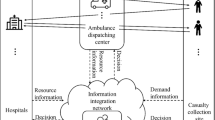Abstract
Efficient resource scheduling and allocation in radiological examination process (REP) execution is a key requirement to improve patient throughput and radiological resource utilization and to manage unexpected events that occur when resource scheduling and allocation decisions change due to clinical needs. In this paper, a Tabu search based approach is presented to solve the resource scheduling and allocation problems in REP execution. The primary objective of the approach is to minimize a weighted sum of average examination flow time, average idle time of the resources, and delays. Unexpected events, i.e., emergent or absent examinations, are also considered. For certain parameter combinations, the optimal solution of radiological resource scheduling and allocation is found, while considering the limitations such as routing and resource constraints. Simulations in the application case are performed. Results show that the proposed approach makes efficient use of radiological resource capacity and improves the patient throughput in REP execution.
Similar content being viewed by others
References
Aickelin U, Dowsland KA, 2004. An indirect genetic algorithm for a nurse-scheduling problem. Comput Oper Res, 31(5):761–778. https://doi.org/10.1016/S0305-0548(03)00034-0
Bard JF, Purnomo HW, 2005. Hospital-wide reactive scheduling of nurses with preference considerations. IIE Trans, 37(7):589–608. https://doi.org/10.1080/07408170590948468
Beck JC, Fox MS, 2000. Constraint-directed techniques for scheduling alternative activities. Artif Intell, 121(1-2): 211–250. https://doi.org/10.1016/S0004-3702(00)00035-7
Błażewicz J, Pesch E, Sterna M, 2000. The disjunctive graph machine representation of the job shop scheduling problem. Eur J Oper Res, 127(2):317–331. https://doi.org/10.1016/S0377-2217(99)00486-5
Brah SA, Loo LL, 1999. Heuristics for scheduling in a flow shop with multiple processors. Eur J Oper Res, 113(1): 113–122. https://doi.org/10.1016/S0377-2217(97)00423-2
Cheang B, Li H, Lim A, et al., 2003. Nurse rostering problems—a bibliographic survey. Eur J Oper Res, 151(3): 447–460. https://doi.org/10.1016/S0377-2217(03)00021-3
Duftschmid G, Miksch S, Gall W, 2002. Verification of temporal scheduling constraints in clinical practice guidelines. Artif Intell Med, 25(2):93–121. https://doi.org/10.1016/S0933-3657(02)00011-8
Elmaghraby SE, 1993. Resource allocation via dynamic programming in activity networks. Eur J Oper Res, 64(2): 199–215. https://doi.org/10.1016/0377-2217(93)90177-O
Glover F, 1986. Future paths for integer programming and links to artificial intelligence. Comput Oper Res, 13(5): 533–549. https://doi.org/10.1016/0305-0548(86)90048-1
Huang ZX, van der Aalst WMP, Lu LD, et al., 2010. An adaptive work distribution mechanism based on reinforcement learning. Exp Syst Appl, 37(12):7533–7541. https://doi.org/10.1016/j.eswa.2010.04.091
Huang ZX, Lu XD, Duan HL, 2011a. Mining association rules to support resource allocation in business process management. Exp Syst Appl, 38(8):9483–9490. https://doi.org/10.1016/j.eswa.2011.01.146
Huang ZX, van der Aalst WMP, Lu XD, et al., 2011b. Reinforcement learning based resource allocation in business process management. Data Knowl Eng, 70(1):127–145. https://doi.org/10.1016/j.datak.2010.09.002
Kim SC, Horowitz I, Young KK, et al., 2000. Flexible bed allocation and performance in the intensive care unit. J Oper Manag, 18(4):427–443. https://doi.org/10.1016/S0272-6963(00)00027-9
Kubzin MA, Potts CN, Strusevich VA, 2009. Approximation results for flow shop scheduling problems with machine availability constraints. Comput Oper Res, 36(2):379–390. https://doi.org/10.1016/j.cor.2007.10.013
Marinagi CC, Spyropoulos CD, Papatheodorou C, et al., 2000. Continual planning and scheduling for managing patient tests in hospital laboratories. Artif Intell Med, 20(2): 139–154. https://doi.org/10.1016/S0933-3657(00)00061-0
Mika M, Waligóa G, Węglarz J, 2008. Tabu search for multimode resource-constrained project scheduling with schedule-dependent setup times. Eur J Oper Res, 187(3): 1238–1250. https://doi.org/10.1016/j.ejor.2006.06.069
Negenman EG, 2001. Local search algorithms for the multiprocessor flow shop scheduling problem. Eur J Oper Res, 128(1):147–158. https://doi.org/10.1016/S0377-2217(99)00354-9
Oddi A, Cesta A, 2000. Toward interactive scheduling systems for managing medical resources. Artif Intell Med, 20(2): 113–138. https://doi.org/10.1016/S0933-3657(00)00060-9
Roland B, di Martinelly C, Riane F, et al., 2010. Scheduling an operating theatre under human resource constraints. Comput Ind Eng, 58(2):212–220. https://doi.org/10.1016/j.cie.2009.01.005
Salimifard K, Wright M, 2001. Petri net-based modelling of workflow systems: an overview. Eur J Oper Res, 134(3): 664–676. https://doi.org/10.1016/S0377-2217(00)00292-7
Spyropoulos CD, 2000. AI planning and scheduling in the medical hospital environment. Artif Intell Med, 20(2): 101–111. https://doi.org/10.1016/S0933-3657(00)00059-2
Verhoeven MGA, 1998. Tabu search for resource-constrained scheduling. Eur J Oper Res, 106(2–3): 266–276. https://doi.org/10.1016/S0377-2217(98)80001-5
Vermeulen IB, Bohte SM, Elkhuizen SG, et al., 2009. Adaptive resource allocation for efficient patient scheduling. Artif Intell Med, 46(1):67–80. https://doi.org/10.1016/j.artmed.2008.07.019
Vilcot G, Billaut JC, 2008. A tabu search and a genetic algorithm for solving a bicriteria general job shop scheduling problem. Eur J Oper Res, 190(2):398–411. https://doi.org/10.1016/j.ejor.2007.06.039
Zhang JY, Lu XD, Nie HC, et al., 2009. Radiology information system: a workflow-based approach. Int J Comput Assist Radiol Surg, 4(5):509–516. https://doi.org/10.1007/s11548-009-0362-6
Author information
Authors and Affiliations
Corresponding author
Additional information
Project supported by the National Natural Science Foundation of China (No. 61562088)
Rights and permissions
About this article
Cite this article
He, Ch. Tabu search based resource allocation in radiological examination process execution. Frontiers Inf Technol Electronic Eng 19, 446–458 (2018). https://doi.org/10.1631/FITEE.1601802
Received:
Revised:
Accepted:
Published:
Issue Date:
DOI: https://doi.org/10.1631/FITEE.1601802




